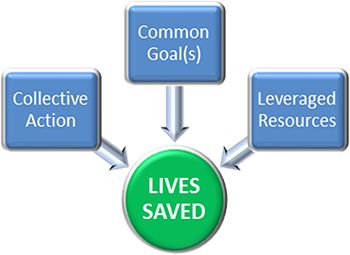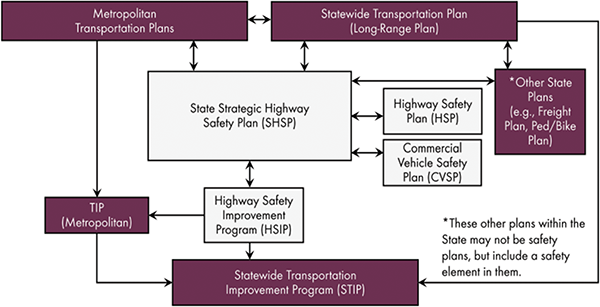The Washington practice is discussed after the following introduction about SHSP integration.
Other states in this SHSP Integration Noteworthy Practices series: DE, ID, ME, MD, ND
Introduction to SHSP Integration
The Strategic Highway Safety Plan (SHSP) is a statewide-coordinated safety plan that provides a comprehensive framework for reducing the number of deaths and serious injuries on all public roads. In each State, the SHSP identifies the State's safety goals, objectives and key emphasis areas. It is intended to serve as an ‘umbrella’ plan that is integrated into other State transportation plans and guides the State's roadway safety investment decisions.
Integration Defined
Integration is the act of bringing together or incorporating various parts into a whole. Integration is relevant and important to a State's planning process because every State has numerous transportation plans; each one potentially addressing safety in a different way. The SHSP is the mechanism to bring these safety “parts” together to form a consistent and “whole” safety program for the State.
The Purpose and Benefits of Integration
The purpose of integration is to coordinate and focus the State's roadway safety efforts to maximize the State's ability to save lives.
Through integration, the safety needs of the State can be addressed more strategically and resources can be shared more effectively. As illustrated in Figure 1, integration encourages State partners to strive toward common goals, collectively implement appropriate strategies and actions, share resources to meet or exceed the State's goals and objectives, and most importantly to save lives.

Other potential integration benefits include:
- The use of consistent data and analysis methods.
- Improved allocation of resources to more effectively produce safety improvements.
- Improvements to safety culture across State, regional, and local agencies.
- A reduction in the administrative burden on States and local agencies.
Integration of Plans and Processes
State transportation plans and programs that the SHSP should be integrated with include the Statewide Long Range Transportation Plan (LRTP), Statewide Transportation Improvement Plan (STIP), State Highway Safety Improvement Programs (HSIPs), the Commercial Vehicle Safety Plan (CVSP), the Highway Safety Plan (HSP) Metropolitan Transportation Plans (TIPs), and various modal and regional transportation plans. The relationship of these plans is illustrated in Figure 2.

An integrated SHSP positions the State DOT and its safety partners to collectively address the State's safety challenges on all public roads through coordination and consistency among with the following State and regional plans and programs:
- LRTPs to promote a long-range vision that incorporates safety priorities.
- HSIP projects to be consistent with the SHSP emphasis areas and strategies.
- STIPS/TIPS to align programming of projects with SHSP strategies and countermeasures.
- CVSPs to facilitate exchange and collaboration between the commercial motor vehicle safety community and the broader safety community.
- HSPs to ensure a consistent, data-driven approach to improving highway safety, especially in SHSP emphasis areas.
In addition, the SHSP should integrate with city and county planning processes to ensure consideration of safety concerns on all road types.
SHSP Integration Indicators
Indicators that the SHSP and other transportation plans and processes are integrated include the following:
- Other transportation plans incorporate elements of the SHSP and include consistent and supporting safety goals, performance measures, objectives, and strategies.
- The priorities and goals of other transportation programs and plans are considered when developing the SHSP.
- Safety partners have access to and use of common safety data, analysis, and methods for determining safety priorities.
- The SHSP is developed with sustained input from disciplines and agencies representing the 4Es of safety (engineering, enforcement, education, and emergency medical services).
- Safety partners assist in the implementation of SHSP strategies.
- SHSP stakeholders and experts are included in other transportation planning processes.
- SHSP priorities and strategies are considered in project prioritization and programming.
- Various sources of funding are used to achieve safety goals.
- Progress towards safety goals is measured jointly and regularly.
Washington
Background
The Washington Traffic Safety Commission (WTSC) is an autonomous state agency responsible for coordinating traffic safety efforts throughout the state of Washington and leading the strategic highway safety plan (known as Target Zero®) development. The WTSC is made up of ten commissioners from State, county, and city government and is chaired by the Governor. The Steering Committee for updating Target Zero® includes representatives from 17 organizations including State, regional, Tribal, and nonprofit agencies. In addition, multi-agency teams have been established to analyze the data and identify and evaluate safety strategies based on stakeholder input.
Target Zero® is a “practitioner's plan” intended to unite the contributing agencies and organizations. The plan will coordinate traffic safety programs, better align priorities and strategies, and provide a common language and approach to traffic safety efforts across Washington State. The plan is data-driven, identifying the factors contributing to fatality and serious injury collisions on Washington roadways, as well as pointing out proven and recommended strategies for reducing traffic deaths and serious injuries.
SHSP Integration Practices
Collaborative Development
The WTSC and the WSDOT have worked collaboratively over the years to develop the SHSP and have established a set of model practices for soliciting and incorporating input from a diverse array of stakeholders when updating their Target Zero® plan. Partner organizations from all over the state have multiple opportunities to provide input—through surveys, active participation in a partners' meeting, and by submitting comments and ideas on drafts of the Plan.
To solicit input from partners throughout the State, the Steering Committee issued a survey and held a day-long partners meeting. For the partners meeting, the Steering Committee invited over 800 participants from public, nonprofit, and private organizations across the State. Approximately 180 participants attended the meeting representing Federal and state agencies, Native American Tribes, local law enforcement agencies, local transportation departments, state legislators, advocacy groups, regional planning councils, and technology companies. At the partners' meeting, WTSC presented statewide traffic safety data and held group strategy discussions with partners on safety priority areas, soliciting ideas. Those facilitated discussions resulted in lists of potential strategies to address each priority area.
Following the partner meeting, subject matter experts in each of the priority areas led multi-agency teams in developing chapters on each of the priority areas. They compiled past successes, documented future plans, and critically examined the potential approaches to reduce fatalities and serious injuries. This resulted in a list of proven strategies that any organization can use to develop their own traffic safety plans.
The strong partnerships among safety agencies in Washington State did not happen overnight. They have been fostered and strengthened over a decade of conscious effort. The SHSP update process in Washington State allows a great array of safety partners with diverse perspectives to come together to have strategic discussions based on a common set of data. Each update of Target Zero® has drawn more partners, which in turn has led to new ideas, changed attitudes and behaviors, and greater coordination of efforts.
Common Goals, Strategies and Measures
Target Zero® is coordinated with other plans, including the Highway Safety Improvement Plan (HSIP), Highway Safety Plan (HSP), and the Commercial Vehicle Safety Plan (CVSP). Representatives from the agencies that steward these plans helped author the associated sections in Target Zero®.
Target Zero® sets common goals and safety strategies for State agencies and provides guidance to local agencies, nonprofit groups, and Tribes in Washington. The priorities identified in Target Zero® are guided by several factors including: the Governor's priorities as expressed in the Washington Transportation Plan, a careful review of traffic safety data and analysis, and input from partners. Target Zero® is intended to be incorporated into the plans and programs of key state traffic safety agencies, as well as other state agencies, Tribes, cities, counties, and private organizations. State agencies are required to integrate Target Zero® into their strategies and plans and it is strongly recommended for all law enforcement, engineering organizations, and any organization involved in traffic safety.
Federally funded programs administered by Washington State agencies set forth criteria to align the priorities and strategies identified in Target Zero®. WTSC also funds Target Zero® managers in local communities who are embedded in public agencies to facilitate traffic safety mobilizations, and implement and support proven Target Zero® strategies. This helps WTSC develop local partnerships and facilitate the implementation of proven safety strategies in key locations statewide.
Tribal Integration
The Steering Committee, which included Tribal representation, has made particular efforts to reach out to the 29 Federally Recognized Tribes located within the borders of Washington State for the Target Zero® update. In 2012, 12 Tribal members representing six Washington Tribes, participated in the partners' meeting and met for a special luncheon that day. Tribal representatives were invaluable in drafting the “Native American Tribes and Target Zero®” chapter of the Plan.
However, on an ongoing basis, Tribal and state representatives meet regularly to discuss transportation and traffic safety concerns. This sharing occurs at meetings of the Tribal Transportation Planning Organization and the Washington Indian Transportation Policy Advisory Committee. Tribes also actively participate on a Tribal Traffic Safety Advisory Board with the WTSC.
Key Accomplishments
- Incorporated input from approximately 180 partners
- Built strong safety partnerships with state, local, Tribal, and nonprofit agencies throughout the State
- Incorporated input from Tribal representatives on safety strategies for reservation roadways
- Set common data-driven goals and proven safety strategies for State, local, and Tribal agencies
See these other SHSP Integration Noteworthy Practices:
Contact
Darrin Grondel
Washington Traffic Safety Commission
(360) 725-9899
DGrondel@wtsc.wa.gov
